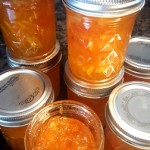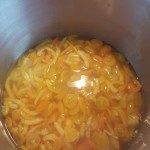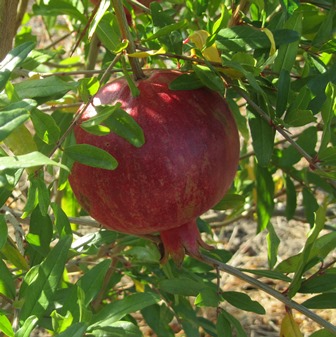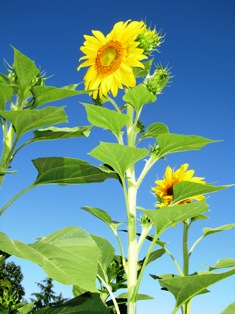How to Make Kumquat Marmalade
Eating a fresh kumquat–the small relative to the sweet orange–is like getting a dose of Vitamin C in a single bite. Or, if you don’t like the tart fruit (the edible rind is sweet), then make your kumquats into a marmalade.
My neighbor recently brought over several boxes of freshly-picked kumquats. We ate some fresh but I turned the rest into a sweet, spread that tastes quite like orange marmalade.
When fruit is available during the year, you can turn that fruit into a delicious conserve, jelly jam, marmalade, or fruit butter. When citrus is in season, oranges, kumquats, grapefruits, and lemons can be coverted to sweet spreads.
There are distinct differences between conserve, jam, jelly, marmalade, and fruit butter. Conserve is a jam made from fruit with other ingredients added, including raisins, coconut, and nuts. Jelly is made from the juice of the fruit while jam is made from the fruit pulp. Marmalade includes fruit, juice, and rind. A fruit butter utilizes the fruit pulp and sugar to make a thick, smooth spread.
KUMQUAT MARMALADE RECIPE
Ingredients:
2 cups thinly sliced kumquats
1.5 cups chopped orange pulp (2 medium oranges)
1.5 cups sliced orange peel (2 medium oranges)
1/3 cup lemon juice
1.5 quarts water
Sugar (the amount will depend on the amount of fruit/water mixture after 12 hours)
Directions:
Mix together all ingredients, except the sugar, in a deep large pot. Simmer for 5 minutes. Remove from heat and cover. In a cool place, allow the mixture to stand for 12 hours or overnight to soften the rind. Remove any large seeds. Cook rapidly until peel has softened. Measure out fruit and liquid mixture and then add 1 cup of sugar for each cup of the fruit mixture. Stir until the sugar is dissolved.
Rapidly bring the mixture to a boil over high heat. Stir as needed to prevent sticking, especially as the mixture thickens and reaches the gelling point. (Hint: You can check to see if the marmalade is gelling by dropping a spoonful of the hot marmalade onto a chilled or frozen saucer. If the marmalade is sheeting instead of running off the plate, it’s ready to can. Also, you can add Classic Pectin according to directions on container to ensure the marmalade properly thickens). Stir in carefully to avoid splattering on your skin. Remove from heat. If the mixture has foam, skim to remove it. And also remove any large seeds that may have been missed.
Ladle the hot fruit mixture into hot jars (run the jars through a hot rinse cycle as the jam is cooking). Leave 1/4-inch headspace. Tighten the ring around the flat, rubber-seal cap. Place the jars into a boiling-water canner. Bring to a boil and process 10 minutes. Remove jars from canner and let stand until cool. The caps will make a popping sound as they cool and seal.
__________________________________________________________________

- All of Meera Lester’s Henny Penny Farmette mysteries are available online and in bookstores everywhere. Also, check out Meera Lester’s self-help books on health, wellness, and spirituality on Amazon.com See: https://www.amazon.com/Meera-Lester/e/B001JP835E
Pomegranate Seeds–A Sweet Explosion on the Tongue
Strolling through our small orchard today, I cut into a pomegranate to check on the seeds–the edible part of the fruit. To my surprise, they had turned ripe. Inside, the seeds were gorgeous red jewels, plump and juicy. The sweet juice in the seeds carries a powerful antioxidant punch, too; it’s loaded with Vitamin C, Vitamin K, fiber, potassium, protein, and folate.
You might wonder about ways of cooking with pomegranate seeds. How about tossing them into citrus or a green salad, pairing them with goat cheese on a crostini, or sprinkling a few on poached pears dipped in chocolate, or incorporate them into a Mediterranean couscous with cashews or pistachios?
I think I’ll make some pomegranate jelly–it tastes great on toast, makes an excellent foil for goat cheese, and also creates a moist and delicious glaze for chicken.
The hardest part of making the jelly is separating the seeds from the white pith that holds the seeds in place inside the leathery peel.
The jelly recipe consists of few ingredients: pomegranate juice, sugar, water, and classic pectin. Here’s how I make the jelly.
POMEGRANATE JELLY RECIPE
Ingredients:
3 1/2 cups pomegranate juice (well strained to remove all the particles)
5 cups granulated sugar
6 tablespoons classic pectin
Directions:
Prepare boiling water canner and wash eight to ten half-pint jars in the dishwasher.
Place rings and lids in a pan of simmering hot water.
Cut one end of the pomegranate off to expose the membranes and seeds.
Section the pomegranate and scrape the seeds out into a medium to large bowl.
Repeat the process until you had several cups of seeds.
Rinse well and then run the seeds through a juice extractor.
Strain out the juice through a jelly bag or multiple layers of cheesecloth. Note: The juice stains, so take care to protect kitchen counters and clothing.
Put the juice and pectin into a large pot and bring to a boil, carefully stirring to blend in the pectin.
Add sugar and stir until completely dissolved and boil for one minute at a roiling boil that cannot be stirred down. Ladle off foam, if necessary.
Ladle jam into clean, hot jars leaving one-quarter inch head space. Attach hot lids and then the rings. Tighten to finger tight.
Lower the filled and sealed jars into the canner. Process for 10 minutes at a roiling boil. Remove and let cool.
* * *
If you enjoy reading about farmette topics (including gardening, beekeeping, and delicious recipes), check out my cozy mysteries A BEELINE TO MURDER and also THE MURDER OF A QUEEN BEE in the Henny Penny Farmette series (from Kensington Publishing).
These novels are available through online retailers such as Amazon, Barnes & Noble, Kobo Books, and Walmart as well as from traditional bookstores everywhere.
See, http://tinyurl.com/hxy3s8q
Now available in mass market paperback, this debut novel launched the Henny Penny Farmette series of mysteries and sold out its first press run.
See, http://tinyurl.com/h4kou4g
The second cozy mystery in the Henny Penny Farmette series, available Sept. 27, 2016, is now available on Net Galley (netgalley.com) for professionals and readers who write reviews. The book may be pre-ordered as well. Click on the link under the image.
Crafts You Can Make from Your Backyard Garden
Invariably, when fall and winter holidays roll around each year, I find myself wishing that I’d planned ahead and utilized more raw materials from the garden for gift-giving. If you have had a similar experience, here are some ideas for turning what you grow into heart-warming gifts.
At summer’s end, harvest the seeds of your favorite flowers like cosmos, sunflowers, nasturtiums, zinnias, and even vegetables. Dry and re-package into paper envelopes that you hand-stamp, emboss, or otherwise embellish for gift-giving. Be sure to include information about how to grow the plant.
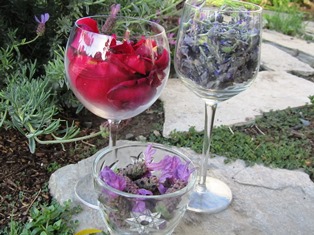
Rose petals, Spanish lavender, and French perfume lavender can be used to make a flower essences or potpourri
Flowers and herbs, picked at their zenith, can be turned into potpourri, fragrant soaps, soothing lotions, and skin moisturizers.
If you keep bees in your backyard garden, consider using the extra wax for dipping candles. Of course, honey is highly prized for its healthful properties, so be sure to jar up plenty of honey for gift-giving occasions.
Vines, berries, and pine cones are easily transformed into wreaths and dry arrangements.
A bottle of vodka, gin, or other spirits can be transformed into a gourmet gift by the addition of sun-ripened berries, herbs, vegetables (such a cucumber), or fruits and then stored in a dark, cool place for at least six weeks.
Gourds make lovely bird feeders and bird houses.
Just imagine the delight a dried-pepper wreath, a garlic braid, or jars of dried beans and seeds might evoke.
Make sheets of homemade paper, incorporating colorful rose petals, lavender, or pansies. Making paper is easy if you have a blender, some scraps of paper (junk mail works), and water.
Seed cakes, created from crunchy peanut butter, seeds, nuts, and dried fruit, make great gifts for bird lovers who can place them near feeders during the cold months when the bird must vigorously forage for food.
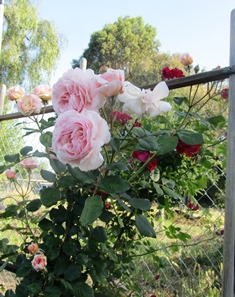
Re-potted cuttings of your garden favorites make lovely gifts for other gardeners in your family or circle of friends
Take cuttings in fall or early spring from your roses, dip the cuttings into root hormone, and plant the cuttings into a pot of soil that you keep damp until the roots have formed. Or dig bulbs (bearded irises, for example) and place in a tin for gift-giving.
Preserve jars of pie-filling, do up crocks of pickles, or create mouth-watering chutneys and special relishes. Wrap the jar lids in gingham and ribbon. Use hot-water canning of fruit and citrus into jam, jelly, and marmalade. Place jars of these items into a food basket, made festive with the addition of colorful tea towels or tissue paper and ribbon.
Use clean, dry corn husks for tamale-making, or craft them into corn husk dolls.
With a little forethought and advance planning, you’ll have plenty of backyard bounty to harvest and turn into gifts for almost any holiday or special occasion.
 Facebook
Facebook Goodreads
Goodreads LinkedIn
LinkedIn Meera Lester
Meera Lester Twitter
Twitter





